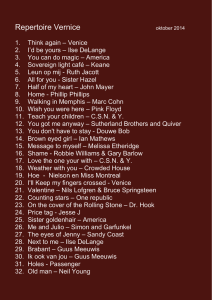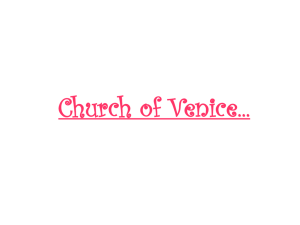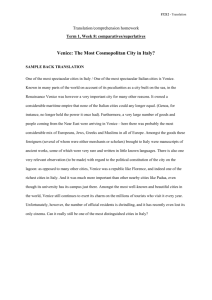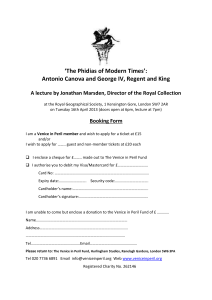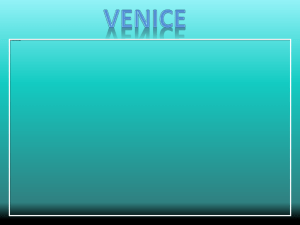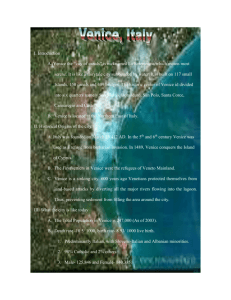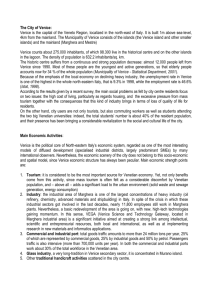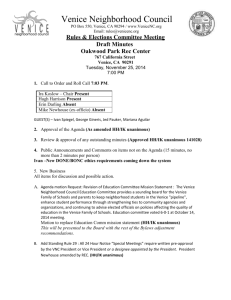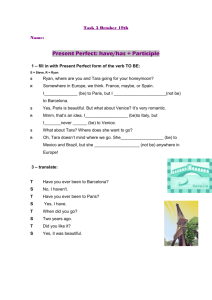11 things to see in Venice
advertisement
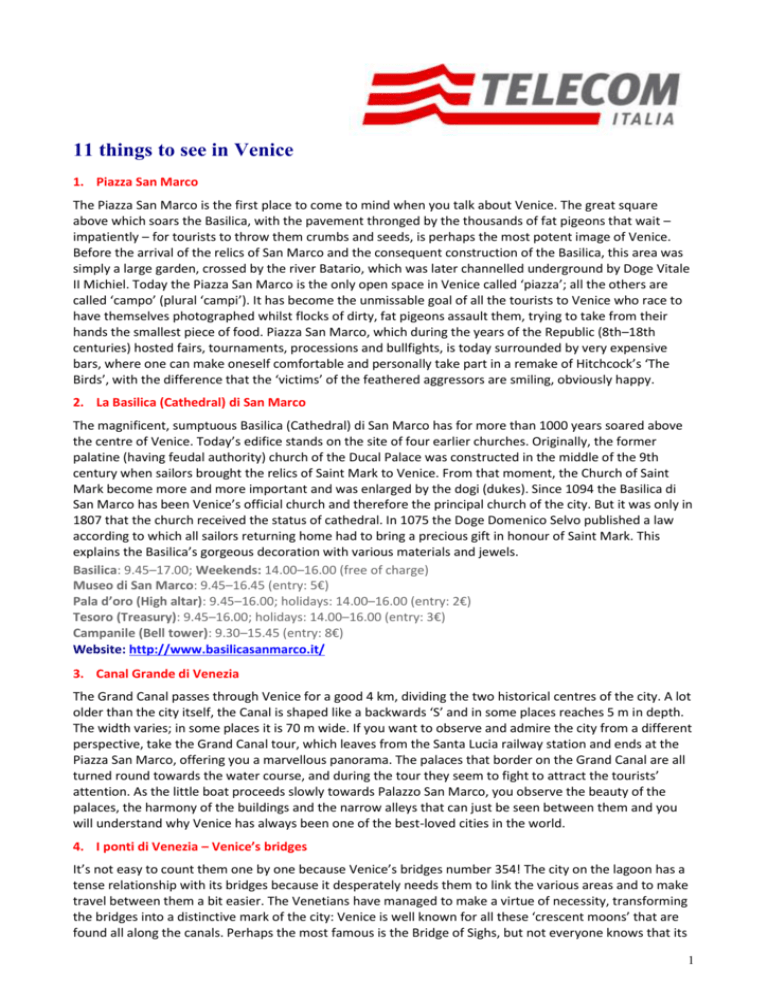
11 things to see in Venice 1. Piazza San Marco The Piazza San Marco is the first place to come to mind when you talk about Venice. The great square above which soars the Basilica, with the pavement thronged by the thousands of fat pigeons that wait – impatiently – for tourists to throw them crumbs and seeds, is perhaps the most potent image of Venice. Before the arrival of the relics of San Marco and the consequent construction of the Basilica, this area was simply a large garden, crossed by the river Batario, which was later channelled underground by Doge Vitale II Michiel. Today the Piazza San Marco is the only open space in Venice called ‘piazza’; all the others are called ‘campo’ (plural ‘campi’). It has become the unmissable goal of all the tourists to Venice who race to have themselves photographed whilst flocks of dirty, fat pigeons assault them, trying to take from their hands the smallest piece of food. Piazza San Marco, which during the years of the Republic (8th–18th centuries) hosted fairs, tournaments, processions and bullfights, is today surrounded by very expensive bars, where one can make oneself comfortable and personally take part in a remake of Hitchcock’s ‘The Birds’, with the difference that the ‘victims’ of the feathered aggressors are smiling, obviously happy. 2. La Basilica (Cathedral) di San Marco The magnificent, sumptuous Basilica (Cathedral) di San Marco has for more than 1000 years soared above the centre of Venice. Today’s edifice stands on the site of four earlier churches. Originally, the former palatine (having feudal authority) church of the Ducal Palace was constructed in the middle of the 9th century when sailors brought the relics of Saint Mark to Venice. From that moment, the Church of Saint Mark become more and more important and was enlarged by the dogi (dukes). Since 1094 the Basilica di San Marco has been Venice’s official church and therefore the principal church of the city. But it was only in 1807 that the church received the status of cathedral. In 1075 the Doge Domenico Selvo published a law according to which all sailors returning home had to bring a precious gift in honour of Saint Mark. This explains the Basilica’s gorgeous decoration with various materials and jewels. Basilica: 9.45–17.00; Weekends: 14.00–16.00 (free of charge) Museo di San Marco: 9.45–16.45 (entry: 5€) Pala d’oro (High altar): 9.45–16.00; holidays: 14.00–16.00 (entry: 2€) Tesoro (Treasury): 9.45–16.00; holidays: 14.00–16.00 (entry: 3€) Campanile (Bell tower): 9.30–15.45 (entry: 8€) Website: http://www.basilicasanmarco.it/ 3. Canal Grande di Venezia The Grand Canal passes through Venice for a good 4 km, dividing the two historical centres of the city. A lot older than the city itself, the Canal is shaped like a backwards ‘S’ and in some places reaches 5 m in depth. The width varies; in some places it is 70 m wide. If you want to observe and admire the city from a different perspective, take the Grand Canal tour, which leaves from the Santa Lucia railway station and ends at the Piazza San Marco, offering you a marvellous panorama. The palaces that border on the Grand Canal are all turned round towards the water course, and during the tour they seem to fight to attract the tourists’ attention. As the little boat proceeds slowly towards Palazzo San Marco, you observe the beauty of the palaces, the harmony of the buildings and the narrow alleys that can just be seen between them and you will understand why Venice has always been one of the best-loved cities in the world. 4. I ponti di Venezia – Venice’s bridges It’s not easy to count them one by one because Venice’s bridges number 354! The city on the lagoon has a tense relationship with its bridges because it desperately needs them to link the various areas and to make travel between them a bit easier. The Venetians have managed to make a virtue of necessity, transforming the bridges into a distinctive mark of the city: Venice is well known for all these ‘crescent moons’ that are found all along the canals. Perhaps the most famous is the Bridge of Sighs, but not everyone knows that its 1 name derives not from the languid sighs of lovers who pass under it, swearing undying love. It seems that the sighs that give the bridge its name are those of the condemned prisoners who were taken from the jail nearby and, seeing the city for last time, gave way to sadness. The most recent of Venice’s bridges, the spectacular Bridge of the Constitution, was designed and built by the Spanish architect Santiago Calatrava. The bridge, commissioned in 1997, after a very long gestation owing to project errors and doubts about its stability, was opened to the public in 2008; it was only a year later that it received its final technical approval. 5. Palazzo Ducale – The Doge’s Palace Venetians attach a lot of importance to this building because it is the guardian of their history and the star in many of the city’s important events. The Palazzo Ducale stood exactly where it is now during the period of the Republic (8th–18th centuries), survived successive changes in sovereignty and was still standing when Venice was annexed to the Italian state (1866). A constant and faithful presence in the city of Venice, the style of the Palazzo Ducale has undergone many significant changes, resulting from a long series of terrible fires. The political significance of the Palace, which was the home of the historical Doges of the Republic of Venice, was underlined by Napoleon Bonaparte when, in 1797, he made it the centre of his administration, after conquering the city. The historical significance of the Doge’s Palace in Venice is also demonstrated by the huge amount paid by the treasury of the new Italian state for the total renovation of the building. Despite the new country’s heavy budget deficit – united Italy took on the debts of all the states merged under the flag – no expense was spared to give one of the most important symbols of Venice a new look. 8.30–17.30 (last entry 16.30). Single ticket valid for: Palazzo Ducale and the complete tour of the Correr Museum, the National Archaeological Museum and the Exhibition Rooms of the Marciana National Library: 16€ Website: http://palazzoducale.visitmuve.it/ 6. Museo (Museum) Peggy Guggenheim a Venezia The Peggy Guggenheim collection is the most prestigious Italian collection dedicated to European and American art of the first half of the 20th century. In the museum you will find the masterpieces of the most important and fascinating artists of the period: Pollock, de Chirico, Picasso, Kandinsky, Brancusi and Duchamp. Of particular interest is the Gianni Mattioli collection – he was one of the greatest collectors of the 20th century – and in his collection the greatest artists of Italian Futurism stand out: Sironi, Carrà, Soffici, Rosai, some paintings by Morandi and a very beautiful portrait by Amedeo Clemente Modigliani. The museum is situated in the only unfinished palace in Venice, the Venier dei Leoni, bought by ‘la Guggenheim’ to create the greatest museum of modern art of the 50s. Peggy’s sole objective in life was to create a museum that would value international avant-garde works. Her passion didn’t end even with the outbreak of the Second World War; during the war years, in fact, ‘la Guggenheim’ continued to tour Europe, heedless of danger, seeking out the works that she wanted to include in her prestigious collection. Open 10–18 every day. Entry: Adults: 14€ Website: http://www.guggenheim-venice.it 7. L’isola di Murano e l’isola di Burano – Murano and Burano Islands Strolling along the two principal canals of Murano, you will pass many glass shops and factories. The manufacture of glass and tourism are the main sources of income for Murano. Murano artistic glasswork is available in all colours, shapes and varieties. Even if you don’t intend to buy anything here, you will be fascinated by the beautiful shop windows and displays. The Palazzo Giustinian (Justinian) houses the Museum of Glass. Here you can wonder at one of the greatest collections of Venetian glass and find out about the history of glass production since Roman times. Also worthy of comment is the Chiesa San Pietro Martire (Saint Peter the Martyr Church) where Giovanni Bellini’s ‘Assumption of the Virgin and the Saints’ and some Veronese paintings can be found. Burano is undoubtedly the most picturesque island in the Venice lagoon. Painted in various colours, the island’s little houses follow one after the other giving a fabulous appearance to the city. Legend has it that the colours helped the returning fishermen to find their way home in the thick fog. The fishing boats are coloured too and are reflected in the water along with the houses. This image is perfectly complemented by the leaning belltower of the little San Martino church. Here you can see Tiepolo’s ‘Crucifixion’. If you are visiting Venice you shouldn’t let the occasion pass of making the 40-minute ferry crossing to visit the idyllic island of Burano – it’s really worth it! 2 8. Le gallerie dell’Accademia – The Accademia Galleries The Accademia Galleries preserve the most important collection of Venetian paintings in the world. The epochs in which the paintings were made range from the Gothic to the Rococo and include works by all the illustrious Venetian painters. The Accademia Galleries occupy a total of three buildings: the Monastery of the Lateran Canons, designed by Andrea Palladio, the Church of Santa Maria della Carità and the Scuola Grande di Santa Maria della Carità. As a result of secularization, the three buildings mentioned above were deconsecrated. Art lovers therefore established a repository for all those works of art that would no longer be safe once the monasteries and churches had been dissolved and the palaces abandoned. In this way the Galleries very quickly amassed an incredibly valuable and unique collection of Venetian paintings from the fifth century onwards. Today you can enjoy this fascinating collection of the Accademia Galleries, distributed over a total of 24 rooms. Mondays 8.15–14.00 (last entry 13.15); Tuesdays to Sundays 8.15–19.15 (last entry 18.30). Closed: Monday afternoons. Prices: €9,00 (+€1,50 for prior reservation) (€11,00 + prior reservation for the ‘Disegni dell ’800 e del ’900’ exhibition) Website: http://www.gallerieaccademia.org 9. La Giudecca The greatest attraction of Giudecca is undoubtedly the Church of the Redeemer, designed by Palladio. The Church of the Old Maids (officially the Church of Santa Maria della Presentazione), which is located on the eastern tip of the island, is also based on the famous architect’s designs. At the other end of the island, on the western end, is the Church of Saint Euphemia. It was dedicated to the Roman martyr Euphemia and houses a beautiful triptych by Bartolomeo Vivarini. A few steps from the church, towards the furthest tip of the island, stands the imposing complex of the Molino Stucky (Stucky Mill). John Stucky’s former pasta factory was transformed into a modern hotel with conference centre (Hilton Molino Stucky) in 2007. 10. Il ghetto ebraico – The Jewish ghetto The oldest ghetto in the world is in Venice itself. Today few Jews live here, but in the 17th century there were more than 5,000 people living in a very small space. Being a maritime trading power in the eastern Mediterranean, Venice soon came in contact with foreign cultures. Not surprisingly, therefore, in Venice there were many cultures and religions. So the attitude towards the Jews was not hostile. But with the rise of anti-Semitism in the 16th century, the Doge decided to move all the Jews into their own neighbourhood, surrounded by four canals and reached only via bridges. At night, the entrances were sealed from the outside. In the Venetian dialect this district was called ‘ghetto’ (‘foundry’). Venice’s ‘Jewish solution’ was soon adopted by other Italian cities and finally by the whole of Europe – and even the name has remained the same until this day. 11. La Scuola Grande di San Rocco Venice’s Scuola Grande di San Rocco is, amongst the six great Schools of Venice, the best preserved. It was founded by two fraternities in 1477 after years of plague and is dedicated to Saint Roch of Montpellier. Venice’s Scuola Grande di San Rocco soon became very wealthy and could afford to establish its headquarters between the two churches, San Rocco and Santa Maria Gloriosa dei Frari. The most famous member of the School was the painter Jacopo Tintoretto who up to 1588 was engaged in the realization of Italian painting’s greatest biblical cycle for this building, which houses some of his greatest works. Scuola Grande: 09.30–17.30 (the Library closes at 17.00). Open every day. Church: 09.30–17.30. Open every day. Full price: €10,00. Website: http://www.scuolagrandesanrocco.it 3
